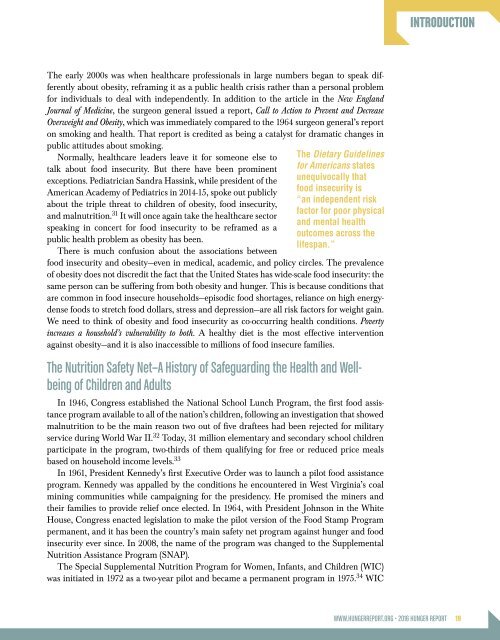THE NOURISHING EFFECT
HR2016-Full-Report-Web
HR2016-Full-Report-Web
Create successful ePaper yourself
Turn your PDF publications into a flip-book with our unique Google optimized e-Paper software.
INTRODUCTION<br />
The early 2000s was when healthcare professionals in large numbers began to speak differently<br />
about obesity, reframing it as a public health crisis rather than a personal problem<br />
for individuals to deal with independently. In addition to the article in the New England<br />
Journal of Medicine, the surgeon general issued a report, Call to Action to Prevent and Decrease<br />
Overweight and Obesity, which was immediately compared to the 1964 surgeon general’s report<br />
on smoking and health. That report is credited as being a catalyst for dramatic changes in<br />
public attitudes about smoking.<br />
Normally, healthcare leaders leave it for someone else to<br />
talk about food insecurity. But there have been prominent<br />
exceptions. Pediatrician Sandra Hassink, while president of the<br />
American Academy of Pediatrics in 2014-15, spoke out publicly<br />
about the triple threat to children of obesity, food insecurity,<br />
and malnutrition. 31 It will once again take the healthcare sector<br />
speaking in concert for food insecurity to be reframed as a<br />
public health problem as obesity has been.<br />
There is much confusion about the associations between<br />
The Dietary Guidelines<br />
for Americans states<br />
unequivocally that<br />
food insecurity is<br />
“an independent risk<br />
factor for poor physical<br />
and mental health<br />
outcomes across the<br />
lifespan.”<br />
food insecurity and obesity—even in medical, academic, and policy circles. The prevalence<br />
of obesity does not discredit the fact that the United States has wide-scale food insecurity: the<br />
same person can be suffering from both obesity and hunger. This is because conditions that<br />
are common in food insecure households—episodic food shortages, reliance on high energydense<br />
foods to stretch food dollars, stress and depression—are all risk factors for weight gain.<br />
We need to think of obesity and food insecurity as co-occurring health conditions. Poverty<br />
increases a household’s vulnerability to both. A healthy diet is the most effective intervention<br />
against obesity—and it is also inaccessible to millions of food insecure families.<br />
The Nutrition Safety Net—A History of Safeguarding the Health and Wellbeing<br />
of Children and Adults<br />
In 1946, Congress established the National School Lunch Program, the first food assistance<br />
program available to all of the nation’s children, following an investigation that showed<br />
malnutrition to be the main reason two out of five draftees had been rejected for military<br />
service during World War II. 32 Today, 31 million elementary and secondary school children<br />
participate in the program, two-thirds of them qualifying for free or reduced price meals<br />
based on household income levels. 33<br />
In 1961, President Kennedy’s first Executive Order was to launch a pilot food assistance<br />
program. Kennedy was appalled by the conditions he encountered in West Virginia’s coal<br />
mining communities while campaigning for the presidency. He promised the miners and<br />
their families to provide relief once elected. In 1964, with President Johnson in the White<br />
House, Congress enacted legislation to make the pilot version of the Food Stamp Program<br />
permanent, and it has been the country’s main safety net program against hunger and food<br />
insecurity ever since. In 2008, the name of the program was changed to the Supplemental<br />
Nutrition Assistance Program (SNAP).<br />
The Special Supplemental Nutrition Program for Women, Infants, and Children (WIC)<br />
was initiated in 1972 as a two-year pilot and became a permanent program in 1975. 34 WIC<br />
WWW.HUNGERREPORT.ORG • 2016 HUNGER REPORT 19


